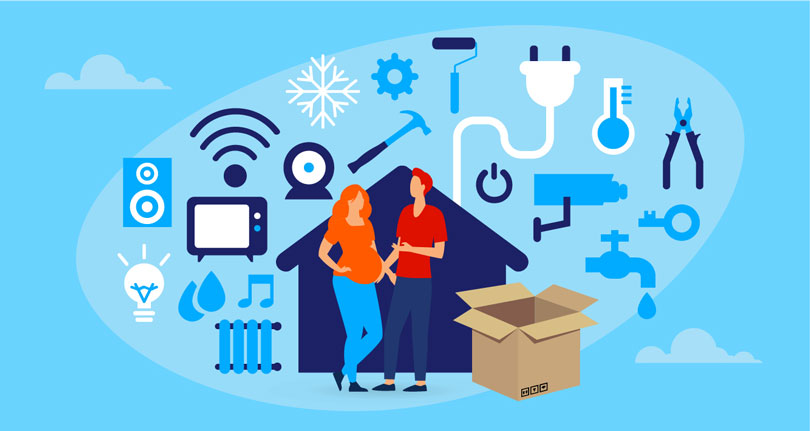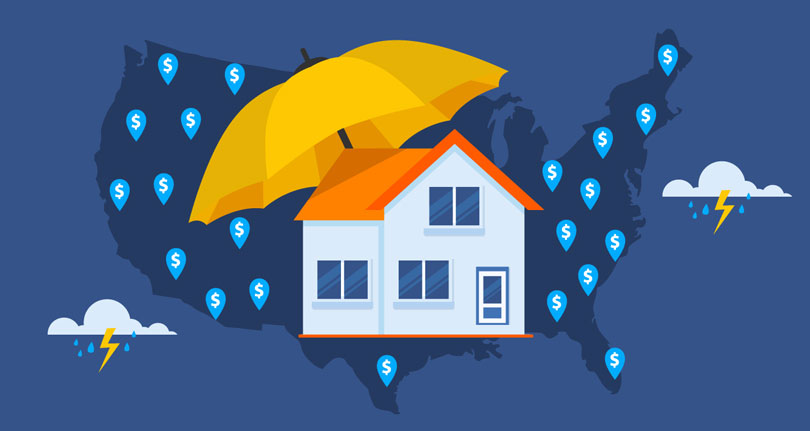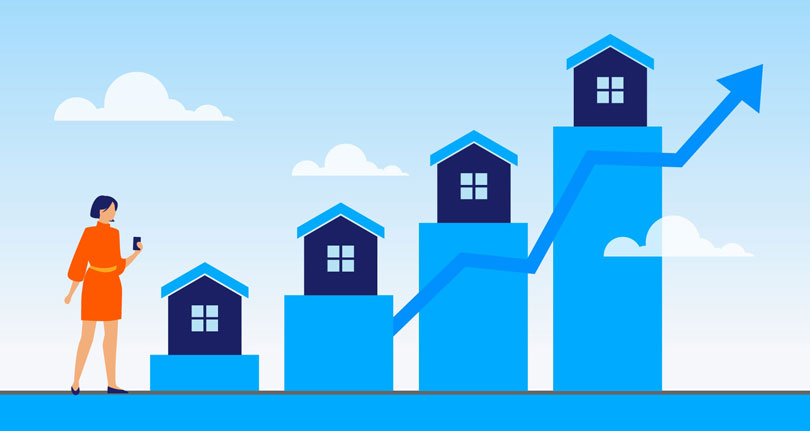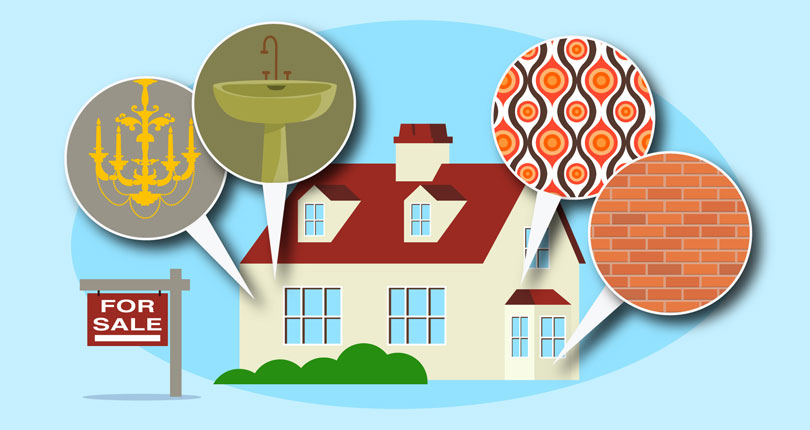The Real Cost of Owning a Home

The latest figures at the end of 2022 stated that two-thirds of U.S. adults own the home they live in. [1] U.S. Census Bureau, ‘QUARTERLY RESIDENTIAL VACANCIES AND HOMEOWNERSHIP, THIRD QUARTER 2022’ https://www.census.gov/housing/hvs/files/currenthvspress.pdf This is a goal that most work towards in their lifetime, and saving up for down payment requires discipline and determination. But the cost of being a homeowner is not simply the amount someone pays when they sign the contract. There are a lot of payments that homebuyers need to factor when they purchase a home, this study aims to review what this looks like.
This research considers the payments homeowners may expect such as mortgage repayments and down payments, but it also factors in insurance, closing fees, moving costs, ongoing maintenance, renovations, and utilities, including WiFi. This list of costs aims to be more reflective of the true cost of homeownership. Read on for the full findings.
Key statistics
- It costs the average American $623,290 to be a homeowner for the average occupancy period of one home (13.2 years).
- Hawaiians spend the most ($1,482,229 over 13.2 years), while those in West Virginia spend the least ($321,194 over the same period).
- The average cost of utilities, including WiFi, for a single family home over 13.2 years is an average of $54,662.
- Mortgage repayments on a typical 3-bedroom home across all states, including private mortgage insurance, homeowner’s insurance, and property taxes, cost an average of $322,147 over 13.2 years.
- The average closing cost fee for a single family home in the U.S. is $5,964.
How much does it cost to own a home?
Taking the average costs from 50 states (and D.C.), this study found that the average single family homeowner(s) will spend an average of $623,290 over 13.2 years of owning a home, which is considered the average length someone stays in one property. [2] Redfin, ‘The Typical U.S. Home Changes Hands Every 13.2 Years’ https://www.redfin.com/news/2021-homeowner-tenure/
You can see how this average cost breaks down in the chart below, as well as the full analysis on this page.
| Category | Cost (13.2 years) |
|---|---|
| Closing costs | $5,964 |
| Mortgage payments | $270,593 |
| Moving fees | $2,112 |
| Utilities (inc. internet) | $54,662 |
| Maintenance & renovations | $192,139 |
| Down payment | $46,266 |
| PMI | $9,189 |
| Homeowner's insurance | $23,221 |
| Property tax | $19,146 |
Cost of homeownership across the U.S.
Most expensive states for homeownership
The study found that Hawaii was the most expensive state for homeownership, costing an average of $1,482,229 over 13.2 years. The Aloha State however does also have the highest average cost for a three-bedroom home ($959,026) [3] Zillow, ‘Zillow Home Value Index (ZHVI), 3-bedroom time series ($)’ https://www.zillow.com/research/data/, so it is to be expected this would heavily impact a lifetime cost of homeownership.
Here is what the study found to be the top five most expensive states for homeownership across the typical lifespan of one home:
- Hawaii ($1,482,229)
- District of Columbia ($1,260,361)
- California ($1,159,617)
- Washington ($963,749)
- Massachusetts ($906,270)
Most affordable states for homeownership
On the other side of the scale, the study found that West Virginia was the most affordable state to be a homeowner, of course, helped by the state’s low average three-bedroom home value of $154,331. [3] Zillow, ‘Zillow Home Value Index (ZHVI), 3-bedroom time series ($)’ https://www.zillow.com/research/data/
The study found the following five states to be the most affordable for 13.2 years of homeownership:
- West Virginia ($321,194)
- Mississippi ($380,794)
- Oklahoma ($390,235)
- Ohio ($394,486)
- Iowa ($400,954)
Maintenance and upkeep costs for a home’s lifetime
Part of the study factored in an average cost for maintenance across the 13.2 years home lifespan, including home improvement projects, an emergency fund, and ongoing annual maintenance.
Data from a survey of over 6,600 American homeowners reveals that when compared to the median home value at the time, each year, homeowners spend approximately 2.69% of the home’s value on home improvement projects, 0.78% on annual home maintenance, and 0.62% on emergency spending. [4] Angi Research and Economics, ‘State of Home Spending’ 2022 https://www.angi.com/research/reports/spending/
| Expenditure | Annual household expenditure | Percentage of home’s value |
|---|---|---|
| Home improvement | $8,484 | 2.69% |
| Home maintenance | $2,467 | 0.78% |
| Emergency spend | $1,953 | 0.62% |
The median home cost in October 2021, when this survey was undertaken, was $315,015, percentages reflect this.
Using these percentages, the study found that Hawaiians would spend the most on maintenance, emergencies, and renovations, at an estimated $517,759 over 13.2 years, while West Virginians would spend just $83,320.
These are only estimates, and the amount of money homeowners need to spend on maintenance depends on the size, age, and location of their property. An average kitchen remodel, for example, can cost anywhere between $14,551 - $40,377, [6] HomeAdvisor, ‘How Much Does A Kitchen Remodel Cost?’ https://www.homeadvisor.com/cost/kitchens/remodel-a-kitchen/ while a bathroom remodel could cost between $6,619 - $16,664. [7] HomeAdvisor, ‘How Much Is A Bathroom Remodel Cost In 2022?’ https://www.homeadvisor.com/cost/bathrooms/remodel-a-bathroom/ These renovations as well as maintenance and an ongoing emergency fund could easily add up for homeowners. (Correct as of 12/12/22. Prices are subject to change.)
Cost of utilities and internet over a home’s lifetime
Homeowners have to consider the cost of heating and cooling their home, as well as water (and waste) bills, and of course, broadband, which around 85% of homes have access to. [8] U.S. Census Bureau, ‘Computer and Internet Use in the United States: 2018’ https://www.census.gov/newsroom/press-releases/2021/computer-internet-use.html
Over 13.2 years, Hawaii spends the most on utilities and internet access ($89,577), with North Dakota ($69,473), and Wyoming ($68,215) behind.
Those in D.C. have the most affordable utilities and will spend an average of $40,310 over 13.2 years, with residents of Illinois getting the second-best deal on average ($42,928), followed by those in Oklahoma ($43,709).
For an average 25 Mbps cable internet access, homes in Wyoming pay an average monthly fee of $196, while those in Rhode Island pay as little as $15.75, [9] HighSpeedInternet.com, ‘States That Pay the Most and Least for Internet in 2020’ https://www.highspeedinternet.com/resources/state-cost-of-internet just one of the reasons for the two states costing more for and less for utilities respectively.
Methodology
All costs in this study are based on an estimated 13.2 years (159 months) spending period, which is considered the average lifespan of owning a home, [2] Redfin, ‘The Typical U.S. Home Changes Hands Every 13.2 Years’ https://www.redfin.com/news/2021-homeowner-tenure/ as well as the cost of purchasing a three-bedroom home, which is the most common size property in America (39.3%). [10] U.S. Census Bureau, ‘American Community Survey: SELECTED HOUSING CHARACTERISTICS’ https://data.census.gov/table?tid=ACSDP5Y2020.DP04&hidePreview=true
Zillow’s average value for a three-bed property (November 2022) was used to calculate the mortgage, closing fees, and down payment fees. [3] Zillow, ‘Zillow Home Value Index (ZHVI), 3-bedroom time series ($)’ https://www.zillow.com/research/data/ A down payment of 13% was assumed across all states as this is the median percentage down payment for all home buyers in 2022. [11] National Association of REALTORS®, ‘2022 Home Buyers and Sellers Generational Trends Report’ https://cdn.nar.realtor/sites/default/files/documents/2022-home-buyers-and-sellers-generational-trends-03-23-2022.pdf
Closing costs were taken from ClosingCorp’s analysis of the average closing costs per state, [12] CoreLogic’s ClosingCorp ‘Average Closing Costs for Purchase Mortgages Increased 13.4% in 2021, CoreLogic’s ClosingCorp Reports’ https://www.closing.com/wp-content/uploads/2022/04/ClosingCorp_2021_Purchase_ClosingCostReport_FNL_4-21_DD.pdf specifically, the percentage of the sales price per state was used and applied to Zillow’s average value in this Self Financial study.
Mortgage repayments including property tax and private mortgage insurance (PMI) were calculated using Bankrate’s Mortgage Calculator in December 2022 [13] Bankrate, ‘Mortgage Calculator’ https://www.bankrate.com/mortgages/mortgage-calculator/ assuming a 30-year loan term, and a 5.26% interest rate (the national average from January - December 2022) as reported by FreddieMac’s PRIMARY MORTGAGE MARKET SURVEY®. [14] FreddieMac, ‘Mortgage Rates Continue to Drop, December 8, 2022’ https://www.freddiemac.com/pmms The study takes 13.2 years of mortgage repayments from a 30-year loan term.
As the study utilizes a 13% median down payment, PMI was calculated as this is typically required for loans with a down payment of less than 20%. [15] Consumer Financial Protection Bureau, ‘What is private mortgage insurance?’ https://www.consumerfinance.gov/ask-cfpb/what-is-private-mortgage-insurance-en-122/ A PMI calculator [16] NerdWallet, ‘PMI Calculator: How Much Is Mortgage Insurance?’ https://www.nerdwallet.com/article/mortgages/pmi-calculator was used (Dec 2022) to estimate monthly payments per state for the 3-bedroom home, with a 13% down payment, a 5.26% mortgage rate, and a credit score of 760+, as the most common credit score in America is between 750-799. [17] FICO®, Average U.S. FICO® Score Stays Steady at 716 https://www.fico.com/blogs/average-us-fico-score-stays-steady-716-missed-payments-and-consumer-debt-rises The calculator factors PMI as a repayment until 20% equity is achieved.
Homeowner’s insurance costs were taken from NerdWallet’s study entitled: ‘The Average Home Insurance Cost in the U.S.’ in October 2022, where they reviewed ‘a variety of insurance companies in every ZIP code across all 50 states and Washington, D.C.’. [18] NerdWallet, ‘The Average Home Insurance Cost in the U.S. for December 2022’ https://www.nerdwallet.com/article/insurance/average-homeowners-insurance-cost
A flat moving cost was applied nationally of $2,183, taken from the moving company, movebuddha’s internal data on the average in-state moving costs in 2022 for a 3-bedroom property. [19] moveBuddha, ‘Moving Industry Statistics’ https://www.movebuddha.com/blog/moving-industry-statistics/ The U.S. Census Bureau shows that the vast majority of house moves are done in-state, therefore classed as local by the moving company. [20] U.S. Census Bureau, ‘U.S. Migration Continued to Decline From 2020 to 2021’ https://www.census.gov/library/stories/2022/03/united-states-migration-continued-decline-from-2020-to-2021.html
To calculate maintenance costs per state, the study uses research from Angi who surveyed 6,400 homeowners on their home maintenance spending. [4] Angi Research and Economics, ‘State of Home Spending’ 2022 https://www.angi.com/research/reports/spending/ Their figures were compared against the median home price of October 2021 [5] Zillow, ‘United States Home Values’ https://www.zillow.com/home-values/102001/united-states/ (when the survey was fielded) to calculate that people spend an annual average of 0.96% of a home’s value on home maintenance, 0.74% on emergency funds, and 3.28% on home improvement projects. These figures were then applied to the median home price of a three-bed home for the study. Comparatively, 0.96% savings for home maintenance is similar to other figures repeatedly reported online of 1%, also referred to as ‘The 1% Rule’. [21] The Balance, ‘Rule of Thumb: How Much To Budget for Home Maintenance’ https://www.thebalancemoney.com/home-maintenance-budget-453820
For monthly utilities, gas, electric, water, and internet fees were considered. Monthly electricity costs come from the U.S. Energy Information Administration for the ‘Residential average monthly bill’ by state in October 2022. [22] U.S. Energy Information Administration, ‘Electric Sales, Revenue, and Average Price’ https://www.eia.gov/electricity/sales_revenue_price/ The average home in America uses 168 cubic feet of gas per day. [23] TECO Peoples Gas, ‘Natural Gas Facts’ https://www.peoplesgas.com/company/ournaturalgassystem/naturalgasfactslinks/ This was used to calculate the average gas cost in each state by using the U.S. Energy Information Administration’s ‘Natural Gas Prices’, of which, a monthly average from September 2021 to August 2022 was taken (the latest data available in November 2022). [24] U.S. Energy Information Administration, ‘Natural Gas Prices’ https://www.eia.gov/dnav/ng/ng_pri_sum_a_EPG0_PRS_DMcf_m.htm Average water bills data comes from RentCafé, [25] RentCafe, ‘What Are Apartment Utilities & How Much Will They Cost Me?’ https://www.rentcafe.com/blog/apartment-search-2/money/apartment-utilities-breakdown/ who used water company rates in three major cities in each state, multiplied by the average household water consumption from the U.S. Geological Survey based on the average household. [26] USGS. ‘Estimated use of water in the United States in 2015’ https://pubs.er.usgs.gov/publication/cir1441
To calculate the average monthly internet cost, a requirement of 25 Mbps was set as this would be the minimum speed to access the internet for basics, such as streaming. Data primarily comes from HighSpeedInternet.com’s internal data [9] HighSpeedInternet.com, ‘States That Pay the Most and Least for Internet in 2020’ https://www.highspeedinternet.com/resources/state-cost-of-internet of over 350,000 internet users in the U.S. Alaska and Hawaii did not have sufficient data in this study, therefore Self Financial collected the average price of monthly broadband for packages with a minimum of 25 Mbps from internet service comparison site, All Connect, in October 2022. [27] Allconnect, ‘Internet providers in Alaska’ https://www.allconnect.com/local/ak [28] Allconnect, ‘Internet providers in Hawaii’ https://www.allconnect.com/local/hi
Sources
- [1] U.S. Census Bureau, ‘QUARTERLY RESIDENTIAL VACANCIES AND HOMEOWNERSHIP, THIRD QUARTER 2022’ https://www.census.gov/housing/hvs/files/currenthvspress.pdf
- [2] Redfin, ‘The Typical U.S. Home Changes Hands Every 13.2 Years’ https://www.redfin.com/news/2021-homeowner-tenure/
- [3] Zillow, ‘Zillow Home Value Index (ZHVI), 3-bedroom time series ($)’ https://www.zillow.com/research/data/
- [4] Angi Research and Economics, ‘State of Home Spending’ 2022 https://www.angi.com/research/reports/spending/
- [5] Zillow, ‘United States Home Values’ https://www.zillow.com/home-values/102001/united-states/
- [6] HomeAdvisor, ‘How Much Does A Kitchen Remodel Cost?’ https://www.homeadvisor.com/cost/kitchens/remodel-a-kitchen/
- [7] HomeAdvisor, ‘How Much Is A Bathroom Remodel Cost In 2022?’ https://www.homeadvisor.com/cost/bathrooms/remodel-a-bathroom/
- [8] U.S. Census Bureau, ‘Computer and Internet Use in the United States: 2018’ https://www.census.gov/newsroom/press-releases/2021/computer-internet-use.html
- [9] HighSpeedInternet.com, ‘States That Pay the Most and Least for Internet in 2020’ https://www.highspeedinternet.com/resources/state-cost-of-internet
- [10] U.S. Census Bureau, ‘American Community Survey: SELECTED HOUSING CHARACTERISTICS’ https://data.census.gov/table?tid=ACSDP5Y2020.DP04&hidePreview=true
- [11] National Association of REALTORS®, ‘2022 Home Buyers and Sellers Generational Trends Report’ https://cdn.nar.realtor/sites/default/files/documents/2022-home-buyers-and-sellers-generational-trends-03-23-2022.pdf
- [12] CoreLogic’s ClosingCorp ‘Average Closing Costs for Purchase Mortgages Increased 13.4% in 2021, CoreLogic’s ClosingCorp Reports’ https://www.closing.com/wp-content/uploads/2022/04/ClosingCorp_2021_Purchase_ClosingCostReport_FNL_4-21_DD.pdf
- [13] Bankrate, ‘Mortgage Calculator’ https://www.bankrate.com/mortgages/mortgage-calculator/
- [14] FreddieMac, ‘Mortgage Rates Continue to Drop, December 8, 2022’ https://www.freddiemac.com/pmms
- [15] Consumer Financial Protection Bureau, ‘What is private mortgage insurance?’ https://www.consumerfinance.gov/ask-cfpb/what-is-private-mortgage-insurance-en-122/
- [16] NerdWallet, ‘PMI Calculator: How Much Is Mortgage Insurance?’ https://www.nerdwallet.com/article/mortgages/pmi-calculator
- [17] FICO®, Average U.S. FICO® Score Stays Steady at 716 https://www.fico.com/blogs/average-us-fico-score-stays-steady-716-missed-payments-and-consumer-debt-rises
- [18] NerdWallet, ‘The Average Home Insurance Cost in the U.S. for December 2022’ https://www.nerdwallet.com/article/insurance/average-homeowners-insurance-cost
- [19] moveBuddha, ‘Moving Industry Statistics’ https://www.movebuddha.com/blog/moving-industry-statistics/
- [20] U.S. Census Bureau, ‘U.S. Migration Continued to Decline From 2020 to 2021’ https://www.census.gov/library/stories/2022/03/united-states-migration-continued-decline-from-2020-to-2021.html
- [21] The Balance, ‘Rule of Thumb: How Much To Budget for Home Maintenance’ https://www.thebalancemoney.com/home-maintenance-budget-453820
- [22] U.S. Energy Information Administration, ‘Electric Sales, Revenue, and Average Price’ https://www.eia.gov/electricity/sales_revenue_price/
- [23] TECO Peoples Gas, ‘Natural Gas Facts’ https://www.peoplesgas.com/company/ournaturalgassystem/naturalgasfactslinks/
- [24] U.S. Energy Information Administration, ‘Natural Gas Prices’ https://www.eia.gov/dnav/ng/ng_pri_sum_a_EPG0_PRS_DMcf_m.htm
- [25] RentCafe, ‘What Are Apartment Utilities & How Much Will They Cost Me?’ https://www.rentcafe.com/blog/apartment-search-2/money/apartment-utilities-breakdown/
- [26] USGS. ‘Estimated use of water in the United States in 2015’ https://pubs.er.usgs.gov/publication/cir1441
- [27] Allconnect, ‘Internet providers in Alaska’ https://www.allconnect.com/local/ak
- [28] Allconnect, ‘Internet providers in Hawaii’ https://www.allconnect.com/local/hi





